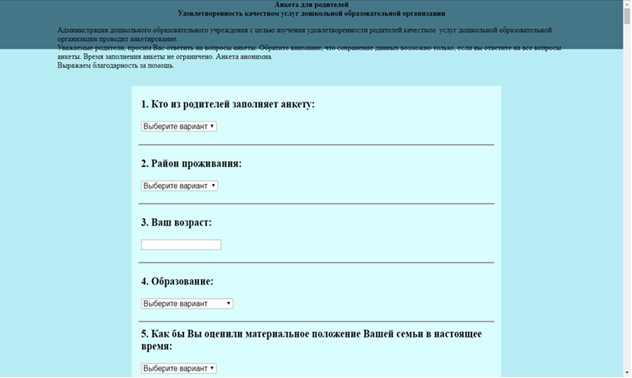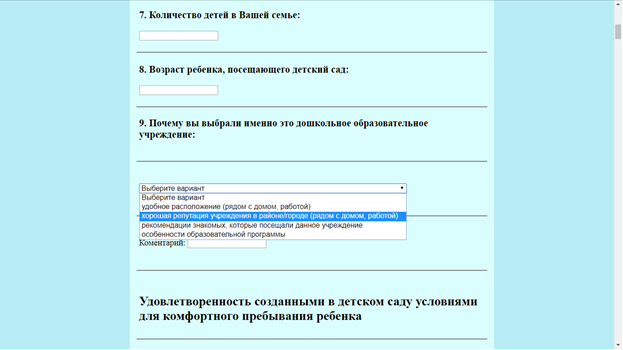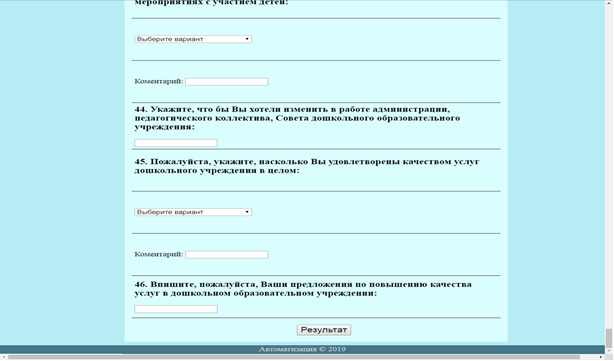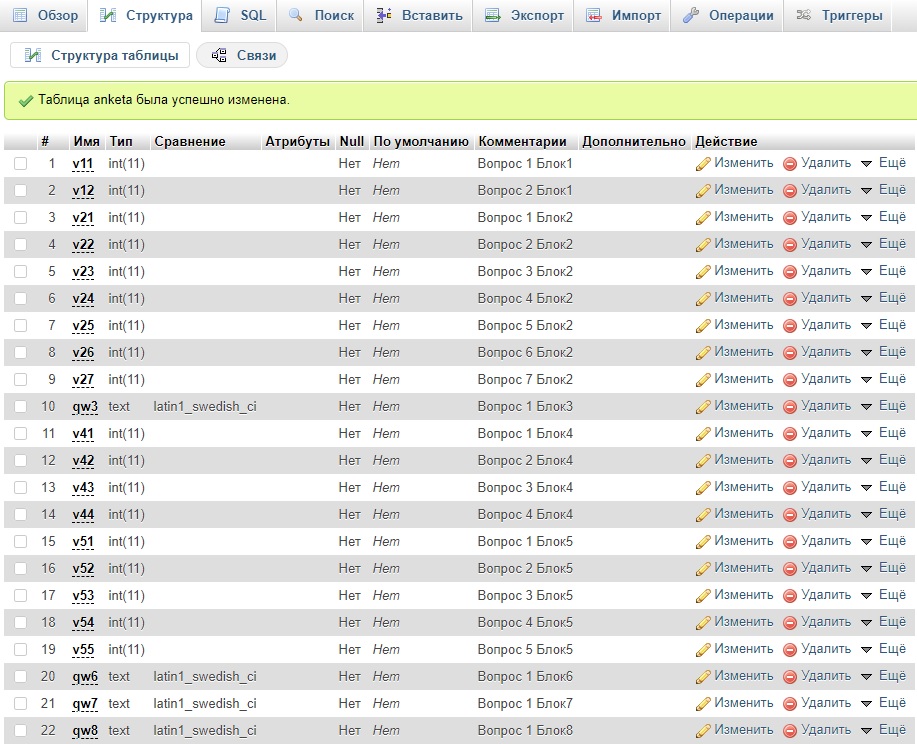Abstract
The article describes the algorithm and principles of operation of an automated system designed to study parental satisfaction with the quality of services provided by preschool education organizations. The relevance of the research is determined by the existing contradiction between the high demand for reliable and relevant information about parental satisfaction with the quality of services provided by preschool institutions from regional and municipal education authorities and administration of preschool institutions, and the insufficiently developed scientific and methodological tools for studying this issue. Successful socialization of a child requires close interaction between his parents or legal representatives with teaching staff and the administration. The study of requests for the services of pre-school educational organizations and their subjective evaluation by customers and consumers is one of the measures for coordinating interests and building cooperation between subjects of educational activities. The questionnaire and database developed by the authors lays the basis of the automated system. The attention given to parental opinion allows identifying the state and significant trends in development of preschool institutions, both at the institutional, municipal and regional levels, to make it possible not only to quickly respond to the social demand, but also to build effective interaction between administration, teachers and parents, to share responsibility for the educational process.
Keywords: Automated systempreschool educationparental involvement
Introduction
Currently there is no universal definition of the term “quality of education”. Due to the diversity of political and socio-economic contexts, systems and resources in different countries there are many definitions of this concept. In general, the quality of education is viewed in close connection with the quality of life in general. For example, many studies examine the impact of education on the economic, social, and environmental development of a country (Ross & Genevois, 2006; Nazar, Chaudhry, Ali, & Faheem, 2018).
The traditional (“economic”) approach to assessing the quality of education is based on quantitative measurable indicators (investments, number of trained specialists, etc.). Supporters of a different position, established in our days (“humanistic”), proceed from the fact that the results of the education system are always determined by its goals, which are based on ideological, social, political and other values. The key indicators are such characteristics of education systems as efficiency, accessibility, relevance, and sustainability. On this basis quality assessment models are built (Barrett, Chawla-Duggan, Lowe, Nikel, & Ukpo, 2006).
Issues and problems related to the quality of education are no longer considered the exclusive prerogative of state bodies. A significant role in dealing with these issues and problems plays civil society and business, since the idea that education is one of the most effective levers of economic growth and sustainable development has been widely spread (Nazar et al., 2018).
High quality of preschool education is recognized internationally as one of the components not only of the sphere of education and upbringing, but of the social welfare system. Preschool education lays the ground of the child’s future, since it largely determines a child’s successful development and training at all subsequent stages. In assessing the quality of education at an early age several aspects are usually considered: the educational program, the characteristics of the environment, the nature of interaction between an adult and a child, and the quality assessment model itself. At the same time, as studies show, the quality of education should be regularly evaluated and analyzed (Sheridan, 2009; Pianta, Downer, & Hamre, 2016).
One of the most important tasks of European states is restructuring of the existing systems of preschool education and upbringing in order to make them more sensitive to the needs and demands of various social groups. In conditions when both parents work, the role of preschool institutions in the upbringing and socialization of children is continuously increasing. Experts examine the role of the family and local community in the upbringing and education of young children in European countries (Oudenkhoven & Khualla, 2010; Brodin, Hollerer, Renblad, & Stancheva-Popkostadinova, 2015).
Back in the 1960–1970s in the West European countries and the USA the concept of “parental involvement” was introduced, which today is understood as a partnership of the family, education institution and society. Parents play a key role in the education process and building communication with educators and teachers, they participate in organizing education process, attract resources of the social environment, and have a significant impact on children's performance. Leadership in the study of parental involvement belongs to American authors (Antipkina, 2017). Education institutions use various practices of involving parents in the education process: communication (conversations with teachers, meetings, etc.), direct participation in life of an institution (technical and logistical support, activities of parent committees, etc.), joint events (cultural, sporting, entertainment, etc.) (Vasilevic, Bjelica, Popovic, & Gardasevic, 2016; Spasojevic, Samardzic, & Travar, 2017; Schneider & Coleman, 2018).
Russian education is undergoing system changes at the present stage, their general goal is to ensure compliance with international standards, informatization, improving material and technical basis of institutions, and professional development of teaching staff. According to the legislation, it is parents who have priority rights to education and upbringing of children, they may take part in management of education organizations, get acquainted with methods of training and technologies used.
In 2013 preschool education was recognized as the first step of the national education system in Russia by introducing the Federal State Standard in preschool education. Prior to its adoption there was no coordinated understanding of the criteria for assessing quality of preschool education in Russian education practice. Currently, the quality of preschool education is defined as the conformity of its processes and results with the state standards, as well as with the needs of various users (children, their parents, etc.). Researchers analyze how it is monitored and supervised at the federal, regional, municipal, and institutional levels (Boguslavskaya, 2017).
Parental satisfaction with the quality of services provided by preschool education organizations, i.e. subjective perception of the extent to which their requirements are met, reflects public assessment of the work carried out by education institutions. Subjective assessment makes it possible to draw a picture of the educational needs of a society.
Such an indicator as “satisfaction of the population with the quality of education” refers to one of the criteria for assessing the effectiveness of the executive authorities of the constituent entities of the Russian Federation. According to the law education authorities should focus their efforts on developing social partnership, creating public quality assessment systems, involving parents and businesses in addressing topical issues of education institutions of a particular territory.
Parents themselves are also becoming increasingly aware of themselves as consumers of educational services. Therefore, their role in the educational process in the scientific literature is considered in more detail (Duryagina, 2018). Although at the same time, sociological studies still show the absence of a clear request from the parents’ side to the educational system in general, and to a particular institution or teacher (Sobkin, Ivanova, & Kaznacheyeva, 2010).
Problem Statement
From the side of regional and municipal administrative structures, and preschool institutions themselves there is a high demand for reliable and objective information about the satisfaction of the parent community with the quality of services provided by preschool education organizations. When such studies are being carried out, scientific expert associations develop their research tools (Aliyeva, Trifonova, Rodina, & Vasyukova, 2013; Koroleva, 2016; Antipkina, Lyubitskaya, & Nisskaya, 2018).
Often the tools which hasn’t been probated or standardized are used, the tools which do not have necessary scientific and methodological grounding. The situation is similar in cases when the study is initiated by preschool educational institutions. The methods they use, as a rule, raise many questions because of lack of personnel capable of examining, diagnosing and interpreting the data collected.
One of the solutions to this problem may be the development and use of automated systems. The automated systems are specially designed software programs installed on a computer for collecting, storing, processing and analyzing information. Automated systems have such advantages as reduction of time and laboriousness of the study, providing transparency and openness of data, and easy accessibility of the obtained data, and coverage of a larger number of respondents. There are more and more scientific papers on information systems used in the management and assessment of the quality of Russian education (Logachev, Samarin, & Tigina, 2016).
Nowadays a certain experience has been accumulated in implementing such automated systems. For example, they are used as multifunctional complexes designed to collect data on the quality of education in a particular region. Experts consider the main tasks in organizing such work are working out the assessment tools database, building the mechanisms for involving public in research, and the technical side. In implementing multi-level quality assessment of education (at the regional, municipal, etc. levels), it is necessary to ground it on a single information basis that will allow comparing the data (Bukacheva & Kuznetsova, 2016).
Automated systems are also used to organize document management for academic disciplines and carry out knowledge assessment for graduates of educational organizations. Most of these systems affect workflow, only a few are designed to supervise, for knowledge assessment and quality control in education. In future, automated systems for collecting, storing and processing data should become multifunctional, i.e. perform the functions of control, planning, organization management, self-examination, personnel certification, integrated assessment of the work of the organization (Logachev et al., 2016).
Recently, automated systems have become popular as a rating tool for preschool educational organizations. Such ratings help to identify the most popular education programs, regional preferences in selecting education programs, to facilitate public control, ensure transparency and openness in the social sphere, reduce corruption, and encourage healthy competition between social institutions. For example, projects for the development of rating systems for state (municipal) pre-school institutions based on the evaluation of their activities exist in the Russian Federation (Volosovets, Kirillov, & Buyanov, 2017).
Research Questions
The main question of the research is to provide the researcher with an automated tool for studying parental satisfaction with the quality of services provided by preschool education organizations.
Purpose of the Study
The purpose of the study is to create an automated system for studying parental satisfaction with the quality of services provided by pre-school education organizations.
Research objectives are:
developing a questionnaire to study parental satisfaction with the quality of services of preschool education organizations;
making the process of survey automated;
designing the database architecture for storage and operational use of the survey results;
describing the algorithm and principles of operation of the automated system, its functional opportunities and application.
Research Methods
The methods employed to carry out the research are:
comparative analysis (in identifying the general and specific features in the researchers’ approaches to the analysis of the "quality of education" concept, in identifying specific features of methodological approaches to assessing the quality of preschool education, characteristics and relevance of parental involvement);
modeling and parameterization of the questionnaire;
database design methods;
object-oriented programming to work out automated systems.
Findings
The developed questionnaire is designed to study parents’ satisfaction with the quality of services provided by preschool educational institutions. It consists of three parts: the first is an introduction, the second is aimed at identifying general information about the respondents, and the third is the main part containing the list of questions. In the introduction the objectives of the study are briefly described, instructions on how to complete the questionnaire are given; the anonym character of the questionnaire is indicated. It also includes gratitude to the respondents for completing it.
The second part contains questions aimed at obtaining information about the child’s parents (gender, age, education, etc.). In the third part there are 46 questions, open-ended and close-ended. On the basis of the analysis of foreign and Russian studies, the following indicators were selected: satisfaction with the level of comfort provided for a child by the preschool education institution; satisfaction with the services provided (educational service and childcare); satisfaction with the quality of communication with the administration of the institution and teachers; satisfaction with involvement in the activities of the institution. The Likert scale was used to assess the satisfaction rate. The respondents should indicate the degree of their agreement or disagreement with a given statement. To do this, the answer options are set in the range from minimum to maximum (completely dissatisfied, partially dissatisfied, difficult to answer, partially satisfied, fully satisfied). All questions are provided with free spaces for answers or comments so that the respondents could clarify their answer, and speak out their concerns. In addition to that, the ability to add a comment of one’s own is also provided after the block of questions for each indicator. In order to achieve reliability, comparability and objectivity of the survey results, the following requirement for a sample of respondents should be observed: one parent respondent for each child.
The automated survey system includes questions with answer options (Figure



To implement and design the database, the MySQL database management system was selected (Figure

Conclusion
The main tasks solved by the developed automated system are: collection, storage and processing of data on parental satisfaction with the quality of services provided by preschool education organizations. Its main advantages include the following characteristic features:
all the respondents’ answers are stored in a database;
to carry out the work only a browser and Internet access are required;
the automated system allows reducing the time for collecting and analysis of information, storing large amounts of data, and transferring them to various mathematical data processing systems.
At the administrative level of a preschool education institution, the automated system gives the opportunity to identify and overcome difficulties in interaction with parents; it draws attention to successful and problematic areas of the institution. At the municipal and regional management level the automated system allows building a meaningful strategy for the development of preschool education organizations, monitoring the quality of the provided services, performing activities aimed at improving the quality of the services, and tracking the compliance of the provided services with the public order.
References
- Aliyeva, T.I., Trifonova, E.V., Rodina, N.M., & Vasyukova, N.E. (2013). Vystraivanie i aprobatsiya modeley otsenki kachestva doshkolʹnogo obrazovaniya [Building and testing models for assessing the quality of preschool education]. Ehlektronnyy zhurnal «Psikhologicheskaya nauka i obrazovanie», 3, 108–118. [in Rus.].
- Antipkina, I.P. (2017). Issledovaniya «roditelʹskoy vovlechennosti» v Rossii i za rubezhom [Research "parental involvement" in Russia and abroad]. Otechestvennaya i zarubezhnaya pedagogika, 1(4), 102–114. [in Rus.].
- Antipkina, I.V., Lyubitskaya, K.A., & Nisskaya, A.K. (2018). Vovlechennostʹ roditeley tretʹeklassnikov v uchebnye dela detey [Parent involvement in children's learning affairs]. Voprosy obrazovaniya, 4, 230–260. [in Rus.].
- Barrett, A. M., Chawla-Duggan, R., Lowe, J., Nikel, J., & Ukpo, E. (2006). The concept of quality in education: A review of the ‘international’ literature on the concept of quality in education (EdQual Working Paper No. 3). Bristol, the UK: EdQual RPC.
- Boguslavskaya, T.N. (2017). Otsenka kachestva doshkolʹnogo obrazovaniya v usloviyakh ego standartizatsii [Quality assessment of preschool education in terms of its standardization]. Problemy sovremennogo obrazovaniya, 4, 142–149. [in Rus.].
- Brodin, J., Hollerer, L., Renblad, K., & Stancheva-Popkostadinova, V. (2015). Preschool teachers' understanding of quality in preschool: a comparative study in three European countries. Early child development and care, 185(6), 221–236.
- Bukacheva, E.A., & Kuznetsova, L.E. (2016). Rolʹ mnogourovnevoy avtomatizirovannoy informatsionnoy sistemy v otsenke kachestva obrazovaniya [The role of a multi-level automated information system in assessing the quality of education]. Nauchno-metodicheskoe obespechenie otsenki kachestva obrazovaniya, 1(1), 44–47. [in Rus.].
- Duryagina, N.N. (2018). Deyatelʹnostʹ nauchno-obrazovatelʹnogo tsentra v otsenkakh roditeley [The activities of the scientific and educational center in the estimates of parents]. Sotsialʹnoe prostranstvo, 1(13), 1–12. [in Rus.].
- Koroleva, S.V. (2016). Otsenka kachestva doshkolʹnogo obrazovaniya: tekhnologicheskiy aspect [Evaluation of the quality of preschool education: the technological aspect]. Pedagogicheskoe obrazovanie v Rossii, 6, 166–171. [in Rus.].
- Logachev, M.S., Samarin, YU.N., & Tigina, M.S. (2016). Avtomatizirovannye sistemy upravleniya kachestvom obrazovatelʹnogo protsessa [Automated quality management system of the educational process]. Moscow: MGUP imeni Ivana Fedorova. [in Rus.].
- Nazar, R., Chaudhry, I.S., Ali, S., & Faheem, M. (2018). Role of quality education for sustainable development goals (SDGS). People: International journal of social sciences, 4(2), 486–501.
- Oudenkhoven, N., & Khualla, R. (2010). Uslugi dlya detey mladshego vozrasta na baze mestnogo soobshchestva: «tri kita» neformalʹnogo, vneinstitutsionalʹnogo i ofitsialʹnogo podkhodov [Community-based services for young children: “three whales” of informal, non-institutional and formal approaches]. Psikhologicheskaya nauka i obrazovanie, 3, 29–40. [in Rus.].
- Pianta, R., Downer, J., & Hamre, B. (2016). Quality in early education classrooms: definitions, gaps, and systems. The future of children, 26(2), 119–137.
- Ross, K.N., & Genevois, I.J. (2006). Cross-national studies of the quality of education: planning their design and managing their impact. Paris: UNESCO.
- Sheridan, S. (2009). Discerning pedagogical quality in preschool. Scandinavian journal of educational research, 53(3), 245–261.
- Schneider, B., & Coleman, J.C. (2018). Parents, their children, and schools. New York: Routledge.
- Sobkin, V.S., Ivanova, A.I., & Kaznacheeva, K.N. (2010). Rebenok v detskom sadu: mnenie roditeley. Sotsiologiya obrazovaniya. Trudy po sotsiologii obrazovaniya [Child in kindergarten: parents' opinion]. Moscow: Institut sotsiologii obrazovaniya Rossiyskoy akademii obrazovaniya [in Rus.].
- Spasojevic, P., Samardzic, M., & Travar, M. (2017). Collaboration of parents and institutions in support of proper development of preschoolers. In 12th international conference on open education as a way to a knowledge society (DisCo) (pp. 452–468). Prague: Microsoft.
- Vasilevic, I., Bjelica, D., Popovic, S., & Gardasevic, J. (2016). Parental satisfaction with work schedule of preschool institutions in Montenegro. Journal of physical education and sport, 16(2), 1017–1022. DOI:
- Volosovets, T., Kirillov, I., & Buyanov, A. (2017). Functional features of the preschool educational institutions with an ethnocultural. European proceedings of social and behavioural sciences, 33, 453–462.
Copyright information

This work is licensed under a Creative Commons Attribution-NonCommercial-NoDerivatives 4.0 International License.
About this article
Publication Date
30 September 2019
Article Doi
eBook ISBN
978-1-80296-068-6
Publisher
Future Academy
Volume
69
Print ISBN (optional)
-
Edition Number
1st Edition
Pages
1-1054
Subjects
Education, educational equipment, educational technology, computer-aided learning (CAL), Study skills, learning skills, ICT
Cite this article as:
Dolidovich*, O. M., Pomazan, V. A., Pomazan, O. G., Mashanov, A. A., Nakonechnaya, E. V., & Suvorova, N. V. (2019). Automated System For Studying Parental Satisfaction With Quality Of Preschool Education. In S. K. Lo (Ed.), Education Environment for the Information Age, vol 69. European Proceedings of Social and Behavioural Sciences (pp. 284-292). Future Academy. https://doi.org/10.15405/epsbs.2019.09.02.34
